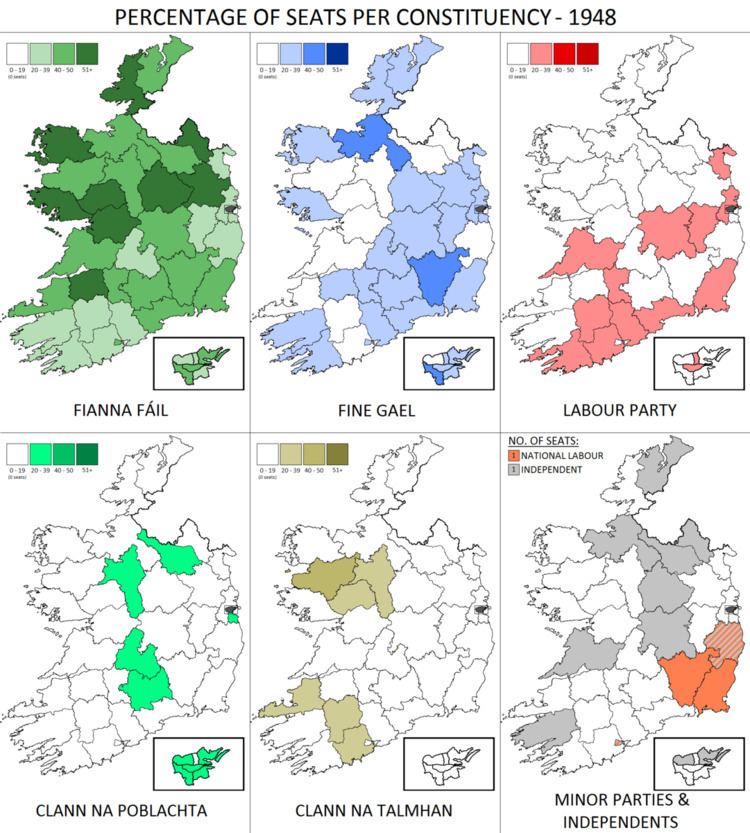4 February 1948 1951 → 26 March 1926 1944 76 seats, 48.9% 30 seats, 20.5% | Turnout 74.2% 1944 1932 30 seats, 20.5% 8 seats, 8.8% | |
 | ||
The Irish general election of 1948 was held on 4 February 1948. The 147 newly elected members of the 13th Dáil assembled on 18 February when the First Inter-Party government in the history of the Irish state was appointed.
Contents
The general election took place in 40 parliamentary constituencies throughout Ireland for 147 seats in the lower house of parliament, Dáil Éireann. For this election the membership of the Dáil was increased to 147 seats, an increase of 9 since the previous election. The 1948 general election is considered an important election in 20th-century Ireland, as it paved the way for the First Inter-Party Government.
Campaign
The general election of 1948 was caused by a desire by the Taoiseach Éamon de Valera, to stop the rise of a new party, Clann na Poblachta. In 1947 the rapid rise of Clann na Poblachta threatened the position of Fianna Fáil. The government of Éamon de Valera introduced the Electoral (Amendment) Act 1947 which increased the size of the Dáil from 138 to 147 and increased the number of three-seat constituencies from fifteen to twenty-two. The result was described by historian Tim Pat Coogan as "a blatant attempt at gerrymander which no Six County Unionist could have bettered."
A number of other issues were raised on the campaign that the parties didn't foresee. Fianna Fáil had enjoyed an uninterrupted sixteen years of dominance in government. Many people believed that the party had become stale and there was a strong desire for a fresh change. Although World War II had ended three years earlier, rationing continued, and massive inflation plagued the economy. A prolonged teachers strike during the lifetime of the previous Dáil damaged the government due to its inability to settle the dispute. Bad weather added to the woes of the farmers, and poor harvests resulted in anger at the ballot box. Allegations that Éamon de Valera and Seán Lemass were involved in bribery and corruption raised questions about certain public officials.
Despite these issues, Fianna Fáil still expected to retain power. This prospect seemed very likely; however, an unlikely coalition was soon to be formed.
Result
When the votes were counted Fianna Fáil remained the largest party in spite of dropping 8 seats. Clann na Poblachta secured ten seats instead of the nineteen they would have received proportional to their vote. The other parties remained roughly the same, with Fine Gael only gaining an extra seat. Fianna Fáil remained the largest party and it looked as if it were the only one capable of forming a government.
Formation of the Coalition
The election left de Valera six seats short of a majority in the 147 seat Dáil. Fianna Fáil had long refused to enter a formal coalition with another party, instead preferring confidence and supply agreements with other parties when it was short of an outright majority. This time, however, de Valera was unable to reach an agreement with National Labour and the Independents with a view to forming a government.
It seemed unlikely that the other political parties could join together to oust Fianna Fáil. However, the leaders of the other parties discovered that between them, they only had one seat fewer than Fianna Fáil. If they could get the support of at least seven independents, they would be able to form a government. On paper, such a motley coalition appeared politically unrealistic. However, a shared dislike of Fianna Fáil and de Valera overcame all other difficulties to knock Fianna Fáil from power for the first time in 16 years.
As the largest party in the coalition, it was a foregone conclusion that Fine Gael would provide the nominee for Taoiseach. The natural choice was the party leader, Richard Mulcahy. However, republicans such as Seán MacBride refused to serve under the man who had been the commander of the Free State forces during the civil war. Since the other parties would have been 17 seats short of a majority (and indeed, would have been 11 seats behind Fianna Fáil) without MacBride, Mulcahy unselfishly stepped aside in favour of John A. Costello, a relatively unknown politician and former Attorney General. Mulcahy, who remained nominal leader of Fine Gael, became Minister for Education. William Norton, the leader of the Labour Party became Tánaiste and Minister for Social Welfare.
On paper, this new coalition government looked weak and seemed unlikely to last. It consisted of a patchwork collection of political parties. There were young and old politicians, republicans and Free Staters, conservatives and socialists. The government's survival depended on a united dislike of Fianna Fáil, the skill of Costello as Taoiseach and the independence of various ministers.
In all the coalition lasted over three years and was successful in several areas.
